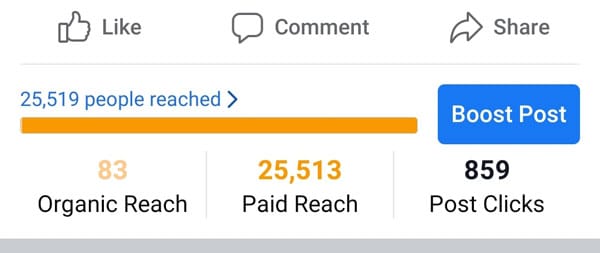On Facebook, the “people reached” figure tells you how many users saw a particular post. In other words, it tells you how many people saw that post on their newsfeed.
This metric is typically located underneath the post, next to the “Boost Post” option.
Take the following example.

In the screenshot above, you can see that it says “784,183 people reached”. This means that 784,183 different people saw this particular post. Most likely, it popped up on their timeline.
Now, let’s take a look at a post that wasn’t as popular.

In this case, only 14 people saw the post in question.
It is important to note that this figure is estimated by Facebook and that it contains both organic and paid reach.
What does “reached” mean?
Let’s take a look at a fictional scenario.
I upload a new image to my Facebook page. Mason, who follows my page, sees it on his newsfeed. This means that my post has now reached 1 person.
However, Mason really likes my post. He likes it so much that he decides to share it on his personal page.
As a result, 10 of Mason’s friends also see the image on their timeline. The post has now reached 11 people.
After that, another page follower called Jennifer sees my image and decides to leave a comment on it. Because Facebook shows you posts that your friends have commented on, my post now appears on the newsfeed of 10 of Jennifer’s friends.
Consequently, my post has now reached 21 people, even though only two of my page’s followers have seen it. In other words, 19/21 people who saw this post are not followers. Instead, they are “friends of followers” who have “engaged” with my image.
Paid vs Organic reach.
If you have ever “boosted” a page post or promoted it, you will have probably noticed that Facebook separates out this “reached” number into two different figures.
These two figures are called “Organic Reach” and “Paid Reach”:

In the screenshot above, you can see the following:
- The post reached a total of 25,519 people.
- Out of those 25,519 people, only 83 saw it organically.
- On the other hand, 25,513 people saw this post because I boosted it.
It is important to note that the figures will not always add up to the total figure that is shown in blue. This is because someone who saw it both organically and via paid reach will be counted in both figures. However, the blue “total” will only show unique users. i.e. If a person sees the same post three times, only one of those views will be included in the “people reached” figure.
Paid Reach.
In the screenshot above, you can see that my “Paid Reach” number is 25,519. However, this does not necessarily mean that I paid for 25,519 people to see it.
Take the following example.
I “boost” one of my Facebook posts. As a result, Sara sees it on her newsfeed. The post catches her eye and she decides to share it or comment on it.
Because of Sara’s “engagement”, 12 of her friends also end up seeing it on their timeline. However, these “views” are not included in the “Organic Reach” number. Instead, they are added to the “Paid Reach” total.
Why? Because Sara’s friends would not have seen the post in question had I not boosted it. In other words, if I hadn’t promoted the post, Sara would not have seen it. As a result, she would not have been able to “engage” with it and share it with her friends.
And that’s it! Hopefully, this post solved any questions that you might have had. If you have any questions or further information to add, feel free to add them to the comments section below!